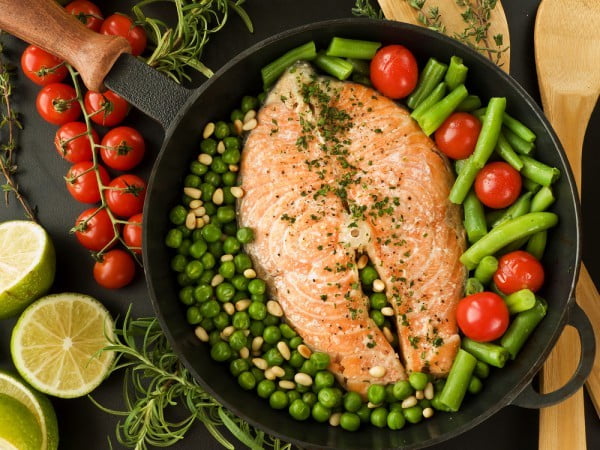10 MOST USEFUL FISH. SAVE THESE!!!


Salmon familyThe most common representatives of this family are salmon, pink salmon and trout.
Salmon meat contains the most Omega-3 fatty acids. Due to the high content of vitamins and microelements (B1, B2, B6, B12, PP, A, E, D, selenium, magnesium, phosphorus and folic acid), eating salmon stimulates blood formation, prevents blood clots, activates metabolic processes, has a beneficial effect on the functions of the liver, nervous, digestive and immune systems.
Pink salmon (in 100 g – 140-170 kcal) contains vitamins A, C, group B, potassium, zinc, sodium and fluorine. They participate in the formation of bone tissue, the functioning of the circulatory system, the activity of endocrine glands and fat metabolism.
Trout less caloric (88 kcal per 100 g of product). Fish contains in varying proportions (depending on the type) vitamins A, E, D, group B, sodium, calcium, potassium, iron, zinc, selenium, manganese, phosphorus, magnesium, copper, fluorine, Omega-3 and Omega-6 fatty acids.

Tuna
There are only 150 kcal in 100 g of tuna, so it is included in dietary nutrition. It contains a huge amount of easily digestible protein (20-26%). Tuna meat contains all the amino acids essential for humans and Omega-3 and Omega-6 fatty acids. The meat of this fish is rich in B vitamins, as well as zinc and phosphorus.

100 g of fish contains 3 g of fat and the caloric value is 103 kcal. Fish meat contains amino acids that maintain the balance of serotonin (the hormone of joy) and melatonin (the hormone of sleep) in the body, nourish brain cells and prevent their death. Therefore, halibut is useful for preventing Alzheimer's disease in the elderly. Halibut also contains Omega-3 fatty acids, B vitamins (B6, B12, B9), D, E, potassium, phosphorus, magnesium and selenium.

Flounder
In addition to high protein, vitamin, essential amino acid and mineral content, fish contains aphrodisiacs and is almost fat-free. Fish is especially recommended for people on a diet.

Cyprinidae familyThe most common representatives of this family are carp, grass carp and crucian carp.
Carp – fish is fatty (up to 12% fat), it contains a lot of saturated fatty acids, which increase the level of cholesterol and protein (12-17%).
In addition, carp contains a lot of calcium (forms bone tissue) and sulfur, which is involved in many vital processes of the body (blood clotting, formation of proteins and enzymes). The fish is rich in potassium, which affects neuromuscular conductivity, and zinc, which is good for the skin.
Carp meat (100 g contains only 97 kcal) and crucian carp (100 g contains about 85-87 kcal) are considered dietary products.

CapelinThe fish contains up to 23% proteins, which are easily digestible. Capelin is rich in calcium, proteins, as well as polyunsaturated fatty acids Omega-3, vitamins of group B (there is several times more vitamin B12 in capelin than in meat), A and D.
Fish contains essential amino acids (methionine, cysteine, threonine and lysine), as well as micro- and macroelements: iodine, fluorine, bromine, potassium, sodium, phosphorus, selenium (10 times more than in meat).

Perch familyPerch and pike perch have excellent taste qualities: the meat is tender, white, lean (100 g contains about 80 kcal). Low calorie and fat content allow using meat during a diet. In addition, it contains proteins, fats, vitamins B, C, E, D, A, PP, macro- and microelements.

PikeFish meat contains natural antiseptics that strengthen the immune system and counteract bacterial infections. Pike is a lean freshwater fish (up to 3%). It is low in calories (84 kcal per 100 g), so it is recommended for dietary nutrition.
Pike is rich in potassium and phosphorus, it also contains calcium, magnesium, sodium, sulfur, iron, zinc, iodine, copper, manganese, fluorine and vitamins (B1, B2, B6, B9, C, E, A, PP).

CodThe white dense meat of cod contains 18-19% protein, it has very little fat (0.3-0.4%) and calories. Cod contains phospholipids and is practically cholesterol-free. Cod roe is also known for its rich composition. Cod affects metabolism, the nervous system, strengthens the immune system, increasing the body's resistance to colds and infectious diseases.

Catfish
The fish meat is soft and tender, with a sweetish taste. Catfish contains a large amount of fats and proteins, all amino acids, vitamins A, B1, B2, B6, B9, C, E, PP, macro- and microelements. Catfish meat is good for the health of the skin, mucous membranes, nervous and digestive systems. It helps regulate blood sugar.